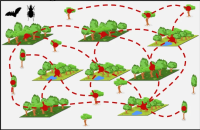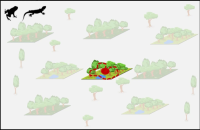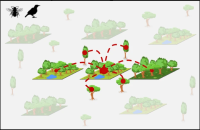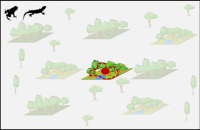In this collaborative paper by 59 co-authors, we asked how the community traits for diverse animals (amphibians, bats, bees, birds, carabid beetles and reptiles) shift with increasing urban land cover in 379 cities around the world. The traits are diverse, with shifts in body size and mobility seemingly driven by changes in dietary and reproductive resources. Our analysis suggests there are taxon-specific shifts in trait composition—especially for reproductive traits— and, in contrast to the common view that there is one unifying “urban trait syndrome”, we propose four, described below. Each accompanying figure panel shows two types of habitat patches with different resources (in green) within the urban matrix, which is largely unsuitable habitat, in grey. The red dashed lines depict typical movement patterns among patches.
These species (bats and beetles) exhibit increased mobility and more generalist diets and reproductive strategies. For example, urban bats are larger (and so better adapted to flying fast and hunting insects in open spaces) and use more diverse roost types.
These animals (amphibians and reptiles) show the opposite trend. For them, resource availability in habitat patches declines in cities and the mortality risk rises in the urban matrix. So, they adapt to a more locally restricted lifestyle. For with reduced dietary breadth, there are more available niches in a patch.
These taxa (bees and birds) have a “home base” area where they nest. Urban bees shift toward solitary nesting and dietary generalism, while urban birds lay fewer eggs and become more omnivorous. These adaptations help them use more diverse resources that are available in the area around their home base.
These animals have less varied diets in cities; they consume foods available in isolated patches and do not have a central place. This syndrome is suggested not by our dataset analyses, but by anecdotal evidence. For example, wading birds are waterbody specialists; by being more mobile, they can fly to new ones when urban conditions change.
Understanding these syndromes is essential to mitigating biodiversity loss on an urbanising planet (e.g., the problem of biotic homogenisation) because it can lead to more effective and future-proof conservation efforts.





